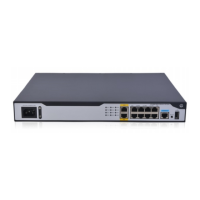51
201505190435
Symptom: Some BGP peers go down and come up after the router is rebooted.
Condition: This symptom might occur if the following conditions exist:
The router is in an IRF fabric or is a distributed router in standalone mode.
The router has a large number of BGP peers.
201507200270
Symptom: An MSR1000 router reboots repeatedly.
Condition: This symptom occurs if the following operations are performed:
a. Install a SIC-4SAE card into the router.
b. Send bidirectional traffic between the router and its peer device.
Resolved problems in CMW710-R0304P02
201505200131
Symptom: Voice services are interrupted during long calls.
Condition: This symptom might occur if E&M non-signaling mode and PCM pass-through are
enabled.
201506290040
Symptom: On a single-MPU router, the fan speed does not increase when the CPU
temperature keeps rising.
Condition: This symptom might occur if the router starts in high-temperature environments.
201505250288
Symptom: NQA TCP operations fail after the router runs for a period of time.
Condition: This symptom might occur if one of following conditions exists:
The interval between NQA probes is shorter than 10 milliseconds.
NQA operations are frequently performed over a long period of time.
201504230250
Symptom: The router displays garbled bandwidth usage-based load-sharing information for an
aggregate interface.
Condition: This symptom might occur if bandwidth usage-based load-sharing is enabled on the
aggregate interface.
201505250277
Symptom: OpenFlow cannot correctly send ARP packets to the SDN controller.
Condition: This symptom might occur if the following operations have been performed:
a. Save the running configuration and reboot the router.
b. Restore OpenFlow configuration by using an .mdb binary file.
201505150431
Symptom: 802.1X authentication fails.
Condition: This symptom might occur if the server issues VLAN IDs, but the length of the
Tunnel-Private-Group-id attribute is not 6 bytes in RADIUS packets sent by the server.

